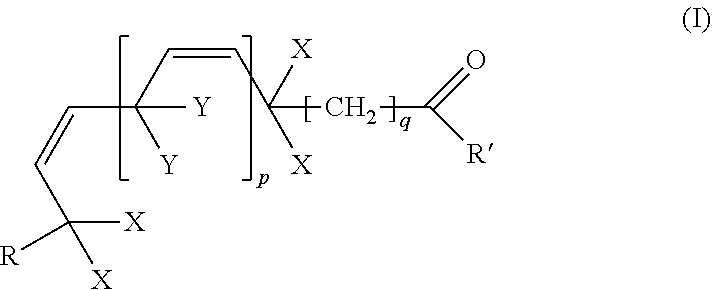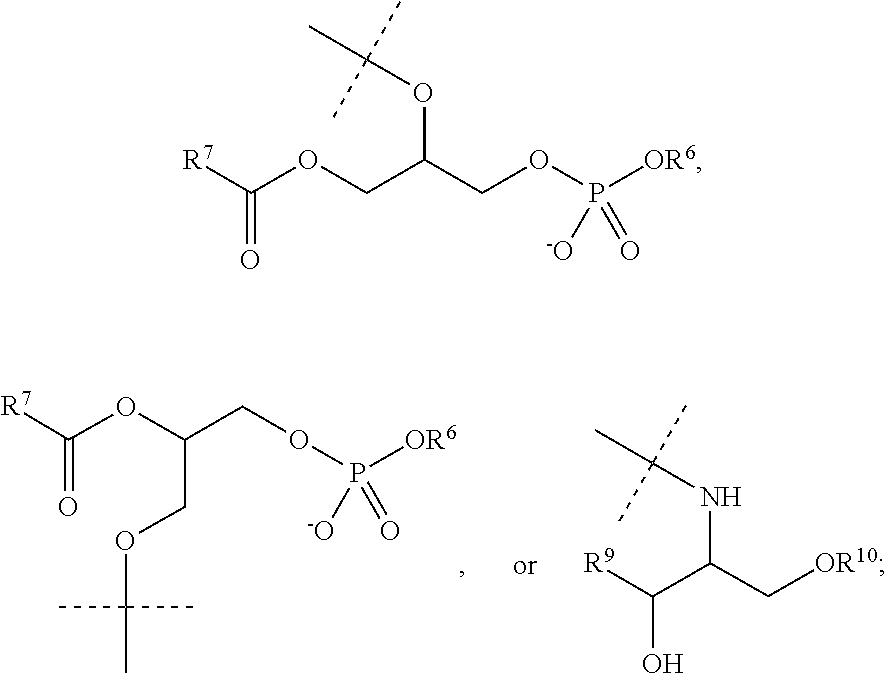Methods for treating tauopathy
a technology of tauopathy and compositions, applied in the field of methods and compositions for treating tauopathy, can solve the problems of loss of balance, slow movement, difficulty in moving the eyes,
- Summary
- Abstract
- Description
- Claims
- Application Information
AI Technical Summary
Benefits of technology
Problems solved by technology
Method used
Image
Examples
example 1
fects on Mitochondrial Membrane Potential
[0214]MMP is an important indicator of mitochondrial health and is typically kept at low values (100-140 mV). A long-lasting drop or rise of normal MMP levels may induce loss of cell viability and various pathologies. ROS and LPO levels are directly linked to MMP, and increase exponentially at MMP>140 mV. Zorova et al., Anal. Biochem. (2018) 552:50-59. Using a fluorescent indicator of MMP, SROS-MSCs showed significantly increased basal MMP compared to control MSCs. Incubation of the cells with D-PUFAs for 72 hours had no effect on MMP for the controls but it reduced mitochondrial membrane potential in the SROS cells from the SROS patients.
example 2
fect on Mitochondrial Structure
[0215]Presynaptic terminals typically contain multiple mitochondria. Misshaped mitochondria can clog the pathways that transport them along neurons and through long axons and elaborate dendritic arbors. Mattson et al., Neuron (2009) 60:748-766. Accordingly, mitochondrial shape is another characteristic of mitochondrial health. Also, the communication pathway between ER and mitochondria through MAM is compromised in misshaped mitochondria, further disturbing protein folding, lipid metabolism, Ca2+ homeostasis and apoptosis. Lee et al., Mol. Cells (2018) 41:1000-1007. Coincident with the improvements in MMP with D-PUFA incubation, the abnormalities of mitochondrial shape seen in SROS MSCs were improved with D-PUFA pre-treatment, resulting in more uniformly looking mitochondria.
example 3
fect on Mitochondrial Number
[0216]The number of mitochondria within the cells is regulated by the balance between mitochondrial biogenesis and mitophagy. Accordingly, for the normal maintenance of the mitochondrial balance, SROS-MSCs should activate mitochondrial biogenesis. However, the level of mitochondrial DNA in the cells, measured by PicoGreen fluorescence in non-nuclear area as an estimation of the number of mitochondria, was significantly lower in SROS-MSC (67.5%), compared to control MSC. Various factors, for example excessive fusion can result in a lower number of mitochondria in the cell, leading to impaired respiration, a lower production of ATP, and increased oxidative damage. Arun et al., Curr. Neuropharmacol. (2016) 14:143-154. However, after 72 hours incubation of the cells with D2-PUFAs mitochondrial DNA increased for both control and SROS MSCs. This was particularly notable in the SROS MSCs, where the level increased even higher than it did in the control (from 67....
PUM
| Property | Measurement | Unit |
|---|---|---|
| Fraction | aaaaa | aaaaa |
| Fraction | aaaaa | aaaaa |
| Mass | aaaaa | aaaaa |
Abstract
Description
Claims
Application Information
 Login to View More
Login to View More - R&D
- Intellectual Property
- Life Sciences
- Materials
- Tech Scout
- Unparalleled Data Quality
- Higher Quality Content
- 60% Fewer Hallucinations
Browse by: Latest US Patents, China's latest patents, Technical Efficacy Thesaurus, Application Domain, Technology Topic, Popular Technical Reports.
© 2025 PatSnap. All rights reserved.Legal|Privacy policy|Modern Slavery Act Transparency Statement|Sitemap|About US| Contact US: help@patsnap.com



